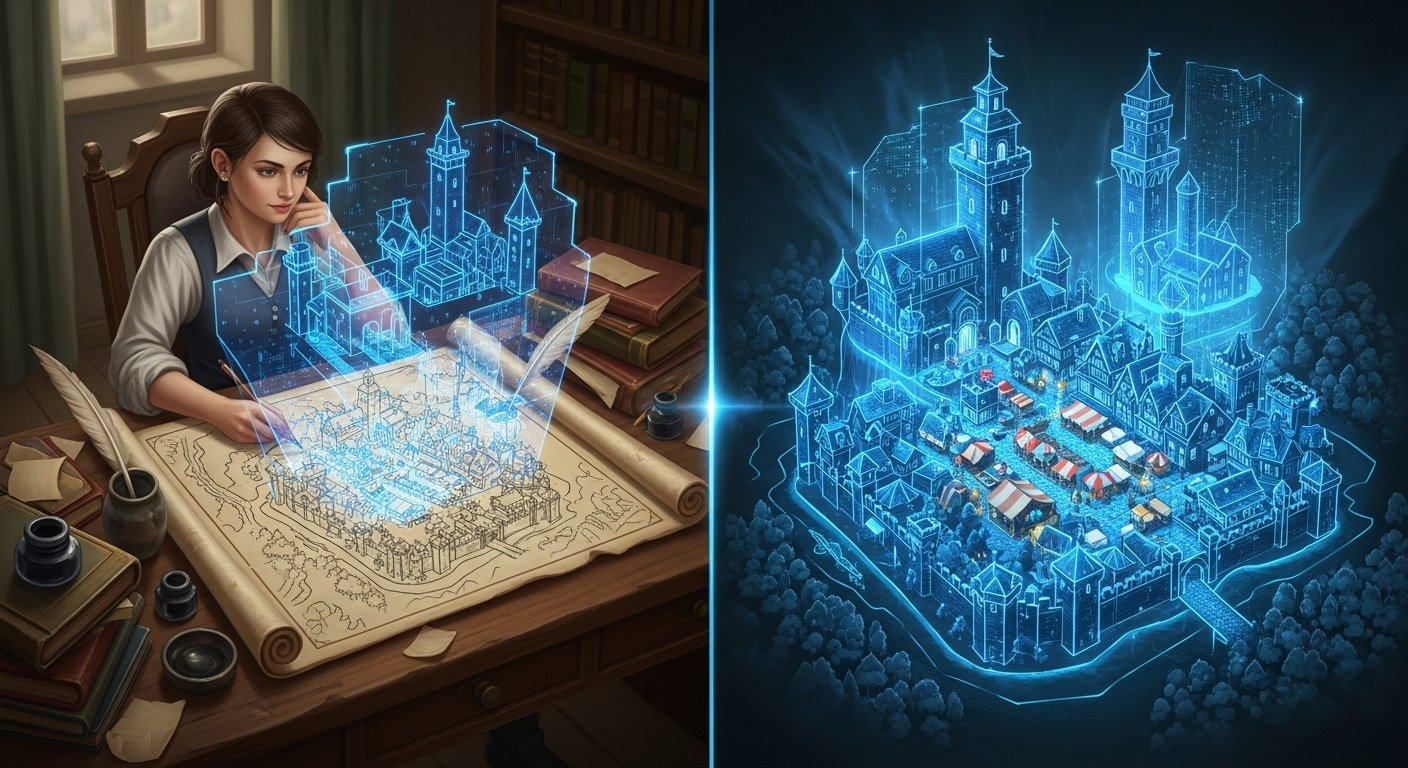Imagine walking through a cobbled street at dusk, torches flickering in the breeze, the silhouette of a castle looming above, and vendors closing up their stalls. That’s the magic of a medieval fantasy town. In modern creative work — from novels and RPGs to worldbuilding for video games — authors and designers increasingly turn to AI (artificial intelligence) to help shape, flesh out, and visualize such places.
In this article, we’ll dig into how you can combine traditional worldbuilding methods with AI tools to create a rich, believable medieval fantasy town. We’ll cover structural design, culture, economy, maps, integration with AI, and pitfalls to avoid. This is your guide to crafting immersive towns that feel alive — enhanced by AI, not dominated by it.
We’ll naturally use the phrase medieval fantasy town -ai throughout, as well as related keywords, while keeping the tone friendly and readable.
Why Use AI for a Medieval Fantasy Town?
Before diving into the how, it helps to understand the why. Even skilled authors or designers can benefit from AI for:
-
Speed & iteration: AI can rapidly generate layouts, building ideas, names, NPCs, or factions which you can refine.
-
Overcoming creative block: When you stare at a blank map or blank page, AI prompts can kickstart directions.
-
Variation & breadth: AI can help you sample many possibilities, some unexpected, which you can then curate.
-
Visualization and concept art: Generative image tools can help you imagine the town’s look and feel, helping later when writing or commissioning art.
But AI is not a substitute for creative direction — you remain the arbiter, the final editor.
Core Elements of a Medieval Fantasy Town
Whether AI-assisted or hand-crafted, these are the essential building blocks to define:
Layout & Geography
A town’s shape and placement are foundational.
-
Site choice: hilltop, river bend, coastal peninsula, valley, or crossroads. Each choice influences defense, trade, and risk (flood, siege, isolation).
-
Walls, gates & fortifications: decide how many gates, wall thickness, towers, and whether there is a moat or natural barriers (cliffs, ravine).
-
Roads & street pattern: radial (from a central hub), grid, organic/winding paths.
-
Districts / quarters: marketplace, artisans’ quarter, religious district, slums, noble quarter, docks, gatehouses, outlying farms.
-
Natural features & landmarks: rivers, springs, hills, woodlands, caves, ruins, watchtowers.
AI tools, especially procedural map generators like Watabou’s Medieval Fantasy City Generator (a browser tool) help you sketch plausible layouts.
Architecture, Materials, and Building Types
A town’s flavor often lies in how buildings look and feel.
-
Materials: stone, timber, wattle & daub, thatch, tile, slate. Use region-appropriate materials: a mountain town might use stone; forested regions timber.
-
Building types & hierarchy:
-
Simple peasant cottages (1–2 rooms).
-
Workshops and guildhalls (smithy, tannery, weaver).
-
Inns, taverns, stables, granaries.
-
Administrative buildings: town hall, guard barracks, courthouse.
-
Religious buildings: temples, shrines, churches, magical sanctums.
-
Noble residences / small castle / manor house.
-
-
Roof styles & ornamentation: gables, dormers, chimneys, wooden balconies, carved stone lintels, gargoyles or magical motifs.
-
Vertical layering: basements, cellars, back alleys, hidden passages — gives depth.
AI image generators can help you remix architectural styles — e.g. “medieval timbered house with mossy roof, dark fantasy lighting” — to help you envision distinct districts.
Society, Culture & Governance
A town is more than walls and buildings — it’s people and power.
Political Structure & Leadership
-
Lord / Mayor / Council / Guilds: Decide who rules and how. Is rule hereditary, elected, or based on magical lineage?
-
Guild influence: Craftsmen guilds (blacksmiths, carpenters, masons, alchemists) can hold political weight.
-
Law, order & justice: Keepers of peace, city watch, militia, constables, perhaps magical enforcers.
-
Factions & intrigue: Noble houses, merchant consortiums, secret societies, religious orders, criminal underworld.
Culture, Religion & Ritual
-
Belief systems: Polytheism, animism, nature spirits, ancestor worship, mage cults.
-
Festivals & rituals: Harvest festival, solstice celebrations, religious pilgrimages, market fairs.
-
Language, dialects & naming conventions: Use consistent linguistic roots.
-
Customs & taboos: Ghosts, superstition about wells or caves, magic usage restrictions.
-
Education & knowledge: Scribes, libraries, mage towers, alchemical labs, secret archives.
Economy & Trade
A functioning town needs commerce and resources.
-
Primary resources & production: Local farming, orchards, vineyards, mines, timber, quarries.
-
Crafts & industries: Metalworking, leatherwork, textiles, pottery, glass, magical goods (e.g. enchanted gems, potions).
-
Trade & merchants: Caravan routes, river trade, port access. Exotic goods generate intrigue.
-
Taxes, tolls & tariffs: On gates, bridges, markets.
-
Guild system & regulation: Quality control, price fixing, guild-owned shops.
-
Challenges & black markets: Smuggling, counterfeit magical items, contraband, bandit routes.
Defense, Threats & Conflict
Conflict makes towns vivid and full of tension.
-
Defensive architecture: Walls, crenellations, watch towers, gatehouses, drawbridges, traps, defensive magic wards.
-
Garrison & military: Soldiers, archers, militia, perhaps magic users or guardian beasts.
-
Threats:
-
External: invading armies, rival lords, monster raids, marauders.
-
Internal: crime, rebellion, plague, famine, magical curses or antagonistic cults.
-
-
Siege mechanics & challenges: supply lines, wall breaches, sabotage, espionage.
-
Secret passages & escape tunnels: Underground networks, secret gates, hidden safe rooms.
NPCs, Stories & Hooks
Characters bring life. Even in a “town map,” thinking of people is crucial.
-
Archetypal NPCs:
-
Town crier or herald
-
Blacksmith, carpenter, brewer
-
Innkeeper & bard
-
Town guard captain
-
Local mage or apothecary
-
Merchant leader or trade lord
-
Religious leader or shrine keeper
-
Thieves’ guild contact or fence
-
-
Conflict seeds & quests:
-
Missing child, monster in woods, corrupt official, plague, smuggling ring, political intrigue.
-
-
Random encounter tables: daily events, emergencies, rumors, visitors.
-
History & lore: origin myths, past disasters, ghost stories, conflicts with neighbors.
How to Integrate AI in This Process
Integrating AI smartly helps you be more efficient and creative, without losing control or coherence.
Using AI for Town Layouts & Maps
-
Use procedural or generative map tools (like Watabou’s generator) to get base layouts.
-
Feed those maps into your prompt to an image generation AI (e.g. Midjourney, Stable Diffusion) with style tags (gothic, whimsical, war-scarred).
-
Ask AI to suggest “district labels” on the map (e.g. “this area is grain silos, this is artisans’ quarter, etc.”)
-
Iterate: select, refine, redraw.
Generating Names & Cultural Details
-
Prompt AI to generate lists of town names (and associated meaning), NPC names, guild names, temple names.
-
Ask for festivals, folk tales, legends, and superstitions that might exist in the town.
-
Have AI suggest variations for names using your language root (e.g. “Eldenfall,” “Silvermere,” “Gareth’s Rest”).
Crafting Descriptions & Scenes
-
Use AI to help write atmospheric descriptions (“the market square just after dawn, mist rising, vendors shouting, stray cats weaving”).
-
Generate dialogues or rumors (e.g. a tavern rumor about a dragon in nearby hills).
-
Ask AI to produce a “tour script” for visitors walking through town.
Balancing AI and Human Judgment
-
Always filter AI output: adapt, edit, discard. AI can produce clichés or contradictions.
-
Maintain a style bible (tone, naming rules, architectural constraints) to keep consistency.
-
Use AI output as inspiration, not final.
-
Cross-check: maps, economy, politics must align logically (resources should match what the surroundings can support, for instance).
Example: A Sample Medieval Fantasy Town -AI Assisted
Let me sketch a small example to show how you might combine everything.
Town Name: Brightwater Crossing
Geography & Layout
Brightwater Crossing sits where a river narrows enough to build a stone bridge. To its east lies woodland; to the west, gentle farmland. The town’s shape is roughly oval, elongated along the river bank.
Key zones:
-
Northern Gate & Wharf District — where riverboats dock, warehouses, fishing piers
-
Market Square (center) — paved stone, fountain, open stalls
-
Artisans’ Wards (east side) — blacksmith, tanner, weaver, carpenter
-
Old Quarter (west side) — winding alleys, older cottages, some ruins
-
Noble Terrace (southern hill) — the manor house, small courtyard gardens, guard barracks
-
Shrine Hill — a small temple to river and nature spirits
Defenses: two gates (north and south), stone walls with three towers, a wooden palisade on river-facing side, and a hidden tunnel to the riverbank.
Architecture & Aesthetics
Buildings mostly built of local grey stone and timber. Roofs of wooden shingles and clay tile. Vine tendrils climb walls near the river. The more prosperous dwellings have carved door lintels and small courtyards. Street lamps use oil lanterns; magical lanterns glow faintly at night around the shrine.
Society & Governance
-
Ruled by Lady Mariane Voss, the hereditary “River Lady.”
-
A town council includes guild masters (weaver, blacksmith, trader) and a cleric representative.
-
A town guard of 30 men, led by Captain Ardon.
-
A secret brotherhood, the Veil of Mist, opposes unchecked magical interference in town affairs.
Economy & Trade
-
Main exports: woven linen, smoked fish, timber planks.
-
Imports: salt, rare spices, magical reagents.
-
Markets held twice weekly on Tuesday and Saturday.
-
Tolls on the bridge; river taxes on passing barges.
-
A small black market dealing in rare magical trinkets and forbidden scrolls.
Conflict / Threats
-
A band of river pirates occasionally raid upriver villages and threaten trade.
-
A swamp to the east hides creatures (bog wraiths, giant frogs).
-
Internal tension: Lady Voss’ son favors pushing out the guilds, which resist.
-
Rumors of a haunt beneath the old quarter: phantom footsteps, whispered voices at night.
NPCs & Hooks
-
Mara the Innkeeper: knows many rumors, maybe part of Veil of Mist.
-
Gorick the Smith: stonemason with a magical hammer rumored to be blessed.
-
Sister Alin: priestess at the shrine, advocates protecting the river spirits.
-
Rowan the Smuggler: small-time, dealing in moon-flower petals, rumors he has secret access to tunnels.
-
Hook: A missing shipment of reagents for the alchemist — who stole them, and why?
This mini sketch gives you a framework; you could prompt AI to generate more details (shops, full NPC personalities, names) and then refine.
Best Practices & Pitfalls to Avoid
Consistency & Internal Logic
-
Don’t let magical elements override physical plausibility (e.g. a large town in a desert with no water source is shaky unless magical).
-
Make sure your economy is sustainable: where do goods come from, what do locals eat, etc.
-
Ensure politics, factions, and conflict make sense to the power dynamics.
Avoid Overreliance on AI
-
AI tends to produce generic tropes — you must add unique flavor.
-
Check for contradictions (AI might say “the town is peaceful” and then “raids nightly”).
-
Avoid AI “hallucinations” (inventions that don’t align with lore).
-
Be mindful of copyright or derivative resemblance when using AI visuals.
Maintain the Human Touch
-
Describe sensory detail: smells, sounds, weather, textures.
-
Use imperfections: worn steps, cracked plaster, rumors, gossip, personal history.
-
Add emotional stakes: what do people fear, hope for, despise?
-
Use show, don’t tell: let characters’ interactions reveal town character.
SEO & Readability Tips
-
Use the primary keyword medieval fantasy town -ai naturally (not forced).
-
Include related keywords like fantasy town design, worldbuilding, AI town generator, medieval town layout, fantasy worldbuilding.
-
Use short paragraphs, bullet lists, headings (as done).
-
Write for humans first, search engines second.
-
Provide value: examples, suggestions, pitfalls, prompts.
Real-World & Fictional Examples
Using examples strengthens your credibility and imagination.
-
Esgaroth (Lake-town) from The Hobbit — built on wooden stilts over a lake, trade-based, vulnerable to dragon attack.
-
Ankh-Morpork in Terry Pratchett’s Discworld — a sprawling mercantile city with guilds holding power, corruption, social depth.
-
Real cities like Istanbul, Prague, or historic towns with layered architecture often inspire fantasy town layouts.
These show how layers of history, conflict, culture, and geography contribute to memorable settings.
Sample AI Prompt Ideas
Here are prompt ideas you can feed to an AI tool (text or art) to help with your town:
-
“Generate 10 names for a medieval fantasy town built beside a river crossing, with linguistic root ‘Val’, meaning valley or water.”
-
“Draw a top-down map of a medieval fantasy town with six districts: market, artisans, noble, docks, temple, old quarter. Use stone walls, two gates, river access.”
-
“Write a rumor that villagers spread about an ancient tunnel under the old quarter of the town.”
-
“Describe the daily life, sights, and smells in the market square at dawn.”
Refine and combine outputs to build your unique town.
Conclusion
A compelling medieval fantasy town, especially when aided by AI, can become more than a backdrop — it can almost feel like a character in your story. By combining traditional worldbuilding (layout, society, economy, defense, NPCs) with AI’s generative potential for maps, names, description, and iteration, you can accelerate your process while retaining creative control and consistency.
Remember: always filter, refine, and humanize what AI gives you. Use it as a tool, not a crutch. Let your creative voice, logic, and vision lead.
With the methods here, you can begin to build a unique medieval fantasy town -ai of your own, filled with depth, intrigue, and memorable life.
FAQs
Q1: Can AI completely design a medieval fantasy town for me?
A: AI can generate base layouts, names, flavor text, and visuals, but it will likely lack coherence, originality, or internal consistency. You should always curate, refine, and edit aggressively.
Q2: Are there free AI tools for town generation?
A: Yes — for example, the Watabou Medieval Fantasy City Generator is a free browser tool for map sketching. Also fantasy town generators exist online.
Q3: How do I avoid my fantasy town sounding cliché?
A: Focus on unique contradictions, flaws, history, and personal stories. Add local color, quirks, dialects, odd traditions, and internal conflict to stand out.
Q4: Should I hand-draw maps or rely only on AI?
A: Using both is ideal. AI or procedural tools give rough structure; hand-drawing or refining lets you tailor landmarks, size, and stylistic choice precisely.
Q5: How many NPCs or factions should a town have?
A: It depends on scale. For a small town, 5–10 meaningful NPCs and 2–3 factions is manageable. Large city: dozens or more. Always tie them to plot hooks or conflict seeds.







Leave a Reply